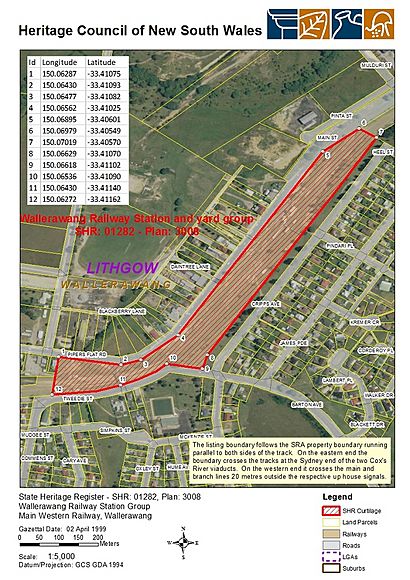Wallerawang railway station facts for kids
Quick facts for kids
Wallerawang
|
||||||||||||||||
|---|---|---|---|---|---|---|---|---|---|---|---|---|---|---|---|---|

Heritage boundaries
|
||||||||||||||||
| Location | Main Street, Wallerawang | |||||||||||||||
| Coordinates | 33°24′28″S 150°04′05″E / 33.4079°S 150.0681°E | |||||||||||||||
| Elevation | 892 metres (2,928 ft) AHD | |||||||||||||||
| Owned by | Transport Asset Holding Entity | |||||||||||||||
| Operated by | State Rail Authority | |||||||||||||||
| Line(s) |
|
|||||||||||||||
| Distance | 171.3 km (106.4 mi) from Central | |||||||||||||||
| Platforms | 2 side | |||||||||||||||
| Tracks | 2 | |||||||||||||||
| Other information | ||||||||||||||||
| Status | Closed | |||||||||||||||
| History | ||||||||||||||||
| Opened | 1 March 1870 | |||||||||||||||
| Closed | May 1989 | |||||||||||||||
| Previous names | Mudgee Road | |||||||||||||||
| Services | ||||||||||||||||
|
||||||||||||||||
| Official name | Wallerawang Railway Station and yard group | |||||||||||||||
| Type | State heritage (complex / group) | |||||||||||||||
| Designated | 2 April 1999 | |||||||||||||||
| Reference no. | 1282 | |||||||||||||||
| Type | Railway Platform/ Station | |||||||||||||||
| Category | Transport - Rail | |||||||||||||||
The Wallerawang railway station is a heritage-listed disused railway station located on the Main Western line in Wallerawang, City of Lithgow, New South Wales, Australia. It is also known as Wallerawang Railway Station and yard group. The property was added to the New South Wales State Heritage Register on 2 April 1999.
History
The station opened on 1 March 1870 as the terminus of the Main Western line when it was extended from Bowenfels. On 1 July 1870 the line was extended to Rydal. Originally named Mudgee Road, it was renamed Wallerawang in 1873.
In 1880 work commenced on the new rail line to Mudgee, the first stage of the Gwabegar line. Completed in May 1882, Wallerawang became a junction station from a junction 600 metres (2,000 ft) west of the station.
With the State Rail Authority replacing the Lithgow to Orange and Mudgee services with road coaches, the station closed in May 1989. Road coach services still call opposite the station.
Description
The complex includes:
- Station buildings
- platform 1 type 1, brick station/residence, 1870
- platform 1 platform awning, 1883
- platform 2 timber waiting shed, 1913
- Signal box
- east, 1915
- west, 1915
- Goods shed - 84 x 24 side shed corrugated iron, 1882
- Platform faces - stone and brick, 1870
- Pedestrian bridge to platform 2
- Water column up main
- Water tank - cast iron tank on metal base
- Jib crane - 1882
- Upper and lower quadrant signals
- Landscaping surrounding the station and yard area
- Enamel signs
Heritage listing
As of 10 December 2002[update], Wallerawang station and yard group is a major railway junction with excellent examples of buildings from a range of periods, all in good condition and in use. The main station building is the best surviving example of a two-storey residence/station and a rare example in stone. The awning is an unusual one-off structure indicating the importance of the location with the need for additional shelter. The on-platform signal box is a rare surviving example of a large brick and timber box in good condition. The yard structures including the residences, goods shed and signal box are all good examples of various building types and remain as remnants of a larger facility. As a group the site has very high heritage significance.
Wallerawang railway station was listed on the New South Wales State Heritage Register on 2 April 1999 having satisfied the following criteria.
The place possesses uncommon, rare or endangered aspects of the cultural or natural history of New South Wales.
This item is assessed as historically rare. This item is assessed as scientifically rare. This item is assessed as arch. rare. This item is assessed as socially rare.

